Arthropods are joint-legged animals with segmented bodies. They typically grow by molting their shells.
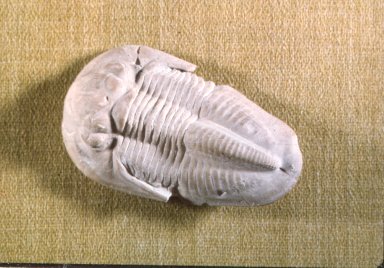
Ameura missouriensis
Description: (Shumard) is the least common of the late Pennsylvanian - Early Permian age trilobites to have been found in Nebraska. It has a stratigraphic range from the Hertha Limestone (Pennsylvanian, Missourian) through the Grant Shale (Permian, Big Blue) in Nebraska. It has been found in older rocks (Desmoinesian) in other states. "A. missouriensis" is normally found in thick, near-shore limestone beds that are called called regressive limestones. These were deposited in shallow, warm water when seas withdrew from the North American midcontinent. Pabian and Fagerstrom (1968) studied this species of trilobite in detail and showed that they grew in a rectilinear mode. "A. missouriensis" has also been found in Illinois, Iowa, Missouri, Kansas, Wyoming, Oklahoma and Texas. The example that is shown here was collected by W. D. "Ted" White, who is a highly respected amateur collector from Omaha, Nebraska, and it is now on display at the University of Nebraska State Museum.
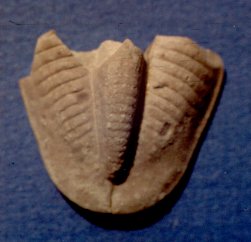
Ameura missouriensis w/bite marks
Description: This tail (pygidium) of "Ameura missouriensis" (Shumard) has two bite marks on right hand pleural lobe and one on the right hand flange of the tail. The fact that these scars show no signs of healing strongly suggests that this trilobite was eaten by a larger predator. The specimen was collected by Bill Rushlau from the Kiewitz Shale beds of the Stoner Limestone member, Stanton Formation near Louisville, Cass County.
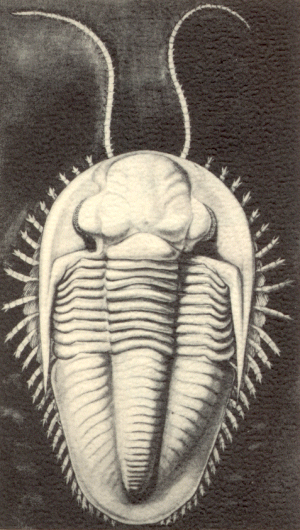
Ameura missouriensis artist's drawing
Description: Artist's reconstruction of large, holaspid specimen, based on 75mm specimen collected from Kiewitz Shale bed, Stoner Limestone Member, Stanton Formation, Late Pennsylvanian, Cass County, Nebraska. Illustration by Mary Tanner.
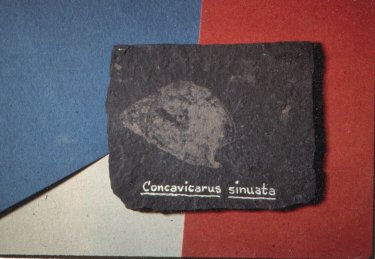
Concavicarids
Description: Concavicarids are arthropods with medium to large, bivalved carapaces that usually have a prominent, concave, anterior notch. The dorsal margin may consist of a fused rostrum which curves downward to close up the notch. The trunk inside the carapace appears to have at least 14 segemnts. This order was named by Briggs and Rolfe (1984) and includes many fossils that were formerly assigned to the phylocarids. They demonstrated that in the concavicarids, the anterior notch can become occluded and not allow sufficient gape for the egress of a posteriorly situated abdomen, as many paleontologists formerly thought. Only one species of concavicarid, "Concavicaris sinuata" (Meek & Worthen), 1872 (seen here) has been recorded from Nebraska; it has been found exclusively in the late Pennsylvanian age black shales, reflecting deep water habitats at maximum marine transgression. Schram (1984) reported them from the Stark and Wea Shales that are exposed in the Lower Platte River Valley in Cass and Sarpy Counties. Geologists from the Conservation and Survey Division have collected specimens from the Larsh Shale Member of the Deer Creek Formation exposed in the Weeping Water Creek Valley in Cass County. Schram (1984) has suggested that the concavicarids of Nebraska were marine organisms that lived in deeper water in proximity to anoxic conditions, and that they were subject to catastrophic kills. Concavicarids have been found almost exclusively on bedding planes of the fissile black shales with their vertical saggital symmetry plane parallel to the bedding planes of the rocks. None have yet been found in concretions (cf. Briggs and Rolfe, 1984) and none have been found in limestone deposits in Nebraska.

D. scitula Ontogeny
Description: Pabian and Fagerstrom (1972) showed that "D. scitula" grew in a rectilinear mode and Pabian, Borovich and Mapes (1993) reconstructed an ontogeny (growth series) of these trilobites that they based on juvenile and adult specimens from Texas, Oklahoma, Nebraska and Kansas.
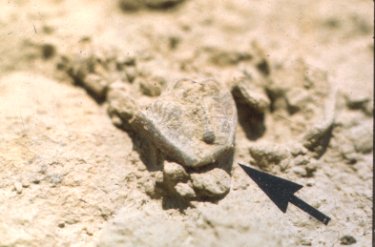
Ditomopyge scitula
Description: "Ditomopyge scitula" (Meek & Worthen) is the more common of the late Pennsylvanian - Early Permian age trilobites to have been found in Nebraska. It has a stratigraphic range from the Hertha Limestone (Pennsylvanian, Missourian) through the Grant Shale (Permian, Big Blue) in Nebraska. It has been found in older rocks (Desmoinesian) in other states. "D. scitula" is normally found in dark gray shale that overlies the fairly thin, dense transgressive limestone. These were deposited in fairly deep, cold water when seas invaded the North American midcontinent. "Ditomopyge scitula" and "Ameura missouriensis" are rarely found together and this reflects the strikingly different environments that each species preferred.

Eurypterus nebrascensis
Description: "Eurypterus nebrascensis" - Barbour is one of the last surviving eurypterids to be found in the fossil record. This example was collected from shale beds in the Indian Cave Sandstone member of the Towle Formation of ?early Permian age near Peru, Nebraska. Eurypterids are arthropods that superficially resemble scorpions although they are probably not closely related. All eurypterids have been found in water-laid deposits. Other eurypterids have been found in Nebraska. The specimens that were found near Peru were all taken from near shore estuary or lagoon deposits that represented brackish water. The other eurypterids from Nebraska have been found in offshore black shale that was deposited in fully marine conditions.

Insect
Description: This wing probably came from a roach-like insect that lived in fern populated forests that existed in southeastern Nebraska near the end of the Pennsylvanian and the beginning of the Permian. It was collected by W. D. White of Omaha, Nebraska, from the Indian Cave sandstone member of the Towle Formation that is exposed between Peru and Brownville in Nemaha counties. These sandstone beds are interfingered with shale lenses that may contain a diverse assemblage of fossils that lived on land and in shallow, near shore stream, lagoon and estuary environments that contained fresh to brackish water. Some insect wings have also been found in rocks of about the same age that are exposed near Humboldt in Richardson County. In addition to the insect wing, eurypterids, horse shoe crab, cephalopod, gastropod, and land plant fossils have been found in these areas.
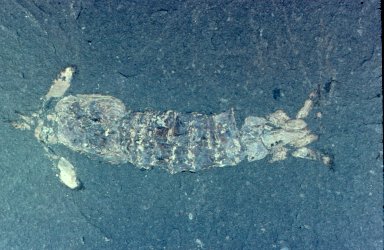
Tyrannophontids
Description: Tyrannophontids are a group of shrimp-like organisms that have been found in the middle and late Pennsylvanian deposits of the North American midcontinent; they were first described by Schram (1969) for specimens that were collected in Indiana and Illinois. Tyrannophontids from Nebraska are represented by the species "Gorgonophontes peleron" Schram, 1984, (seen here) which has been found in the Heebner Shale exposed in Weeping Water Creek Valley, Cass County, and in the Wea, Stark shales exposed in the lower Platte River Valley, Sarpy county, and in the Hushpuckney shale exposed in the Lower Platte River Valley, Sarpy County, and in very deep quarries near Fort Calhoun, Washington County. Although concavicarids have been found in the black Larsh Shale in Weeping Water Creek Valley, Cass County, no tyrannophontids have been found there suggesting the family may have become extinct by that time. Schram (1984) described them as benthic forms that lived along the edge of an anoxic (oxygen deficient) basin in much the same kind of environment as the concavicarids above. Tyrannophontids are usually preserved as imprints on bedding planes of black, fissile shales; the impressions may be enhanced by various organic or mineral residues. They have an extensive fossil record in Nebraska and other parts of the North American midcontinent.